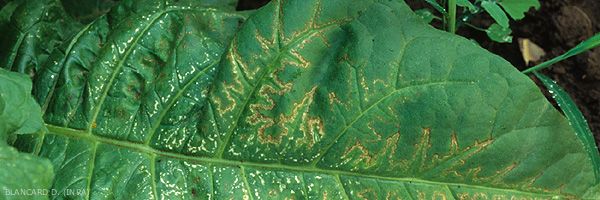
Cucumber mosaic virus
(CMV)
- classification : Bromoviridae, Cucumovirus
Cucumber mosaic virus (CMV), is an ubiquitous and highly polyphagous virus (figure 1). Several strains of CMV can be differentiated according to their biological characteristics (symptoms or temperature sensitivity), and serological criteria based on molecular properties. The differentiation criteria have distinguished two groups of strains; different names have been given to those groups.
 |
| Figure 1 |
CMV is distributed worldwide, but its impact on tobacco varies greatly from one country to another. It is severe in Asia, especially in China, Japan and Taiwan, alone or in combination with other viruses. The severity is similar in Europe, especially Italy, Spain and France, where the virus is widespread in cultures and greatly depreciates the quality of harvested leaves. In France, the damage caused by CMV is underestimated because the symptoms diminish over time, particularly after topping. Also, the relationship between the incidence of this virus in the crops and the depreciation of the quality of harvested tobacco leaves is not always established. It is also present in other countries like the United States, India, the Philippines ... but the losses seem insignificant.
It is never easy to determine with certainty the impact of a disease in a field, especially that of a viral nature. For example, we cite recent studies done in Italy, under experimental conditions in the field. In these studies there was a high incidence of CMV in tobacco. In addition to yield losses, there was a decrease of 50% of the market value of production. Furthermore, significant reductions in total alkaloid content were found in tobacco infected with CMV, alone or in combination with PVY.
CMV should be considered a harmful virus to tobacco in the country where it is commonly observed in crops.





